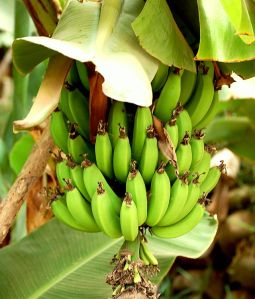Thanks to human-induced climate change, we are digging our own graves by endangering our food system. Sure everyone is aware that there is a drought going on in California jeopardizing certain crops and industries. Yes, everyone is also aware that there is a crisis going on with honey bees and that they account for 1 out of 3 bites of food that we take, but are people personally taking account for their actions? Nope. They’re still buying Round-Up at Home Depot. They are still planting invasive species and decorative species that starve bees rather than help them. They are still watering their lawns and carelessly using water.
Besides the global bee crisis and drought, there are some staples in our food system that are close to collapse – with or without bees. Due to climate change, there seems to be a rise in disease and fungus. Breakfast will never be the same. How would our mornings be without that latte? Or a cup of orange juice? Or that bowl of oatmeal without slices of banana?
Coffee
A new study came out recently from the Royal Botanic Gardens at Kew in England that 70 percent Arabica beans could be nonexistent in 36-66 years. With a warming climate also comes disease and pests and mountainsides that are now becoming too warm for the beans to flourish. When the plants are exposed to warmer temperatures the beans grow and mature too fast resulting in foul, bitter tasting coffee. The warmer temps also allow pests like berry borer beetles and diseases like leaf rust fungus to thrive. The study showed a very high risk of extinction of the world’s 2nd favorite warm beverage (after tea, which is not in as much danger as coffee, yet). Sadly, the study leans towards the conservative side because it did not take into account extensive deforestation in the highland forests of Ethiopia and South Sudan, so it could be a whole lot worse.
Citrus
This 2013-2014 citrus season has been Florida’s worst season in 29 years. This is due to a disease called greening which infected the entire state’s population of citrus. It impedes the trees’ ability to hang onto its fruit and the harvest falls before it can mature. This has affected grapefruit, oranges, tangerines, and tangelos. The price for citrus has already risen domestically. In addition to the fungus, there is also an introduced little Asian pest that is eating away at citrus in California (besides the drought) that is not helping our lemons and limes. Environments that were previously uninhabitable to pests are becoming more inhabitable as they become warmer.
Banana
There is a serious threat attacking bananas all over the world that has yet to reach the banana crop in Latin America, the world’s largest exporter of bananas, but really, it’s only a matter of time. There’s this fungus called Panama disease that rots the shallow and fragile roots of the banana trees. It was found in Asia in the 1990s and recently it has been decimating the banana crop in Mozambique. Some scientists already believe that the fungus has already spread to Latin America, which provides us with 70% of the world’s bananas. Should the fungus continue to spread, and should we find no cure, economies and countries collapse and we will lose the beloved banana.
We need to start taking account for our actions and educating ourselves about the threats to our food system. This is only a fraction of the food that is suffering at our hands. While larger issues of climate change may seem far away and not affect us directly, like melting icebergs in Antarctica, our morning breakfast is in our kitchens every day. Perhaps more people will be willing to make little changes in their daily lives to make big change in the long run.


